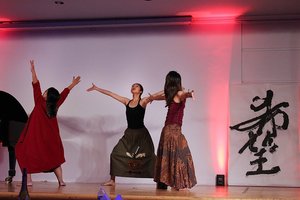Urban Tribe
by Luchia Meihua Lee
The subject of the "Urban Tribe” is a portion of the urgent topic of globalization. From this wider subject, focus in on cultural issues in a new community that has been created typically in the big city. I question whether hybridity is a sufficient description of the profound and ever-present opposition between remaining faithful to tradition and adapting to the circumstances of the enveloping milieu. We might find a self-sufficient group in any ethnicity developing its own cultural identity, and diverging significantly from their original character. Yet the members of Urban Tribes do not completely take on the living style of the larger population in which they reside, and it is the differences that are most interesting. Here, I would like to use a fresh perspective to view small and possibly even isolated pockets of disjointedness, and then interpret them in a worldwide and international context.
In these multi-disciplinary projects, artists reinterpret the sense of the culture term “Tribe” in terms of urban reactions in the community. Nowadays, the definition of “Tribe” has already transformed to apply to a wider group, defined by ethnicity, national origin, language etc. The program will focus on underlining the diversity of life in and fostering interactivity with the community on Environmental subjects.
Globalization not only influences the international business climate, but also affects the national scene and local tribal natives. As one example, this is apparent among that part of the indigenous population in Taiwan which has moved from ancestral lands to the city. Some contemporary artists create a new language and means of expression from the aboriginal heritage – indigenous ritual, belief, cultural elements, and reverence for the environment. These works could involve individual tribal members or tribal groups – either as subjects or as artists.
Perhaps the most jarring change in the transition from pastoral homeland to urban milieu for aborigines is the loss of ritual and myth, or more accurately the wrenching need to adapt these human needs to the encountered environment. Myth is a connection to the divine, and artists are best equipped to mediate a new connection that is relevant to city life and shakes off the dust of mundanity.
Here, the interconnection between the mind, body, nature, culture, and how artists work with this concept of the urban tribe create work that is constructed to pull a viewer through a symbolic journey of language and materials. Thoreau wrote of culture as “The Enchanter” and how immersing oneself in nature is the only way one can answer two simple yet indispensable questions without the influence of certain aspects of culture: how much is enough and how do I know what I want? He felt only in nature could one truly hear one’s own heart, divorced from the influence of cultural voices. The rituals and ceremonies and symbolic nature of the urban tribe act as a doorway back into both nature and the natural voice of the individual and group – divorced from the programming of specifically capitalist and consumer culture.
 |
| Sarah Walko studio installation |
This is a multi-disciplinary project that will span different ethnic groups and tribes. All work presented in this exhibition will be contemporary art, produced either by aborigines – Taiwanese or American – or by contemporary artists commenting on the urban environment. Artists will be chosen not only on the basis of special indigenous background, but also because tribal culture has been incorporated into their work, with special emphasis on those living in the city, but taking the environment into account and using ritual to express a concern for the land.
 |
| TAAC Gala performance |
No comments:
Post a Comment